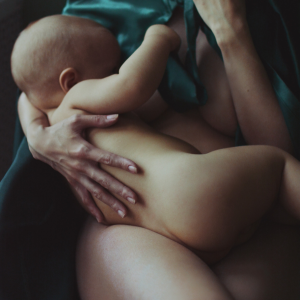Skin-to-skin contact with your baby

The simple act of snuggling your baby on your bare chest has powerful benefits and helps babies adjust and adapt to life outside of the womb.
Skin-to-skin. So Simple. Hugely Powerful.
It is as simple as it sounds and is when baby snuggles on mum or dad’s chest bare chest, covered in a warm blanket. Skin-to skin is good for all babies, whether they are breastfeeding or formula feeding.
Babies need lots of skin-to-skin with mum and dad, both in hospital and at home. Skin-to-skin time is precious time and one of the loveliest moments in birth:
The benefits of skin-to-skin
- Triggers the powerful oxytocin ‘hormone of love’ that lowers mums stress levels as well as promotes healing and mothering.
- Calms your baby ensuring that they feel safe and cared for.
- It can help to reduce cortisol (stress) levels in baby.
- Helps baby to cry less.
- Regulates your baby’s body temperature, breathing rate, heart rate and blood sugar following birth.
- Improves baby’s oxygen saturation levels.
- Helps your colostrum (the first milk that is full of nutrients that protect baby) to flow more easily.
- Stimulates baby’s digestion and encourages an interest in instinctive feeding behaviour.
- When breastfeeding, it will boost baby’s immune system and helps to protect against illness and disease.
- Helps mum to breastfeed longer by building her milk supply and helping her to make a stronger connection with baby.
- If expressing milk, volumes improve if mum expresses following a period of skin-to-skin contact.
- Builds a strong baby brain.
- Increases baby’s senses of touch, taste, textures, smells and sounds the baby experiences in their environment while they are on mums or dad’s chest.
- Gives mums a chance to take a rest or take a break.
- The rush of hormones does not just happen to mums. A similar rush happens when dad has skin to skin contact with baby. For your new-born, the next best thing is skin to skin with dad.
- Research shows that it relaxes dad too and has an important parenting role.
- Promoting an important bonding experience between a father and his new-born child.
Skin-to-skin with baby is vital in neonatal units where it is sometimes known as ‘kangaroo care.’
From the Start
What happens during this special time?
The first hour after birth is sometimes called the Golden Hour. It is an incredibly special bonding time that begins when your baby is snuggled skin to skin with you right after they are born. Baby emerges from the warm dark haven of your womb (uterus) into an unfamiliar world. It is cold by comparison and has new lights and sounds. When a mum holds her baby in skin to skin after birth, it initiates a strong response connecting the mum’s body to the baby’s body. It connects the mum’s brain to the baby’s brain and the mums mind to the baby’s mind. Your baby can be soothed by hearing the comforting sound of your heartbeat, which is familiar from time in the womb. If you talk softly, baby will recognise your voice and will also be familiar with dad’s voice.
After birth you can expect the baby will have:
- The first birth cry. It is so distinctive.
- A relaxation period as they recover from the birth
- Increased alertness. Opening their eyes, looking at you for the first time, responding to familiar voices, smells, and becoming more active, moving hands to mouth, and exploring your breast and suckling for the first time.
Make undisturbed and uninterrupted skin-to-skin part of your birth preferences if your baby is stable. Discuss with the Midwives before your birth that you wish to treasure and enjoy this special time.
Allow yourself plenty of time to hold your new-born and gaze at them.
Most healthy term babies will follow this process, providing that they are not interrupted by anything. Most routine things like putting on baby identity bands and checks can be done with baby skin to skin and obtaining a birthweight can be delayed until after this important period. Try not to hurry or interrupt this process as some babies and mums take a little longer particularly after a long or difficult labour or birth when adrenaline levels have been higher. Stress reduction with skin to skin helps to maintain new-born blood sugar levels and general stability. Let it continue for as long as you wish if there are no concerns for the health of you or baby. Skin to skin is an important part of the care provided by your maternity team following birth, so they will know to prioritise this crucial time.
This also and importantly applies to babies born by assisted and caesarean section birth.
Dad may also like to be prepared and wear a loose tee shirt or shirt that can be unbuttoned so that he can easily snuggle baby skin to skin. Your midwife will show you how to hold your new baby.
The benefits of skin-to-skin care extend beyond the moment of birth. Skin to skin can take place at any time a baby needs comforting or calming. There is no specific age when skin to skin should stop if your baby is happy with it. It provides powerful benefits for baby the entire time they are an infant, in the hours, days, weeks and months to come. Ongoing skin to skin contacts during the early days and weeks release oxytocin and prolactin which can give stress reliving benefits for mum too.
If your baby has medical problems and needs urgent treatment, it may not be possible for either of you to hold baby straight away. Any touch is a comfort to your baby. If you cannot cuddle baby skin to skin, you could hold their hand so they can feel your warmth and recognise your smell.
You can catch up with skin to skin as soon as you are both well enough. Whenever you start skin to skin, it will have lots of benefits for your baby, and for your relationship.
How to do skin-to-skin?
If you are doing immediate skin to skin following birth, the midwife will dry your baby, place them on your chest and cover baby’s back with a clean dry towel or light blanket. The midwife will continue to observe both you and your baby. That is all there is to it!
You can lie down with your baby on your chest, if you are sure, you won’t fall asleep. Ask for assistance when you need it.
Otherwise, sit up while holding your baby skin to skin, and keep baby upright with their chest against your chest. Wearing a nappy on baby is ok if you are worried about soiling.
You are allowed to ask for help. In fact, you should.
Following birth, feeling tired afterwards is very normal and it can take time to ease into motherhood. Motherhood is full on and lots of mums can find it hard to ask for help. Do not be afraid to reach out for help and support from midwives, other health professionals, family and friends as you adjust to life with your new baby. Identifying things that people can help with and allowing others to support you is a giant leap to nurturing yourself.




